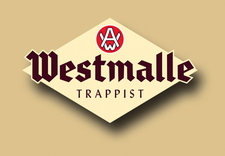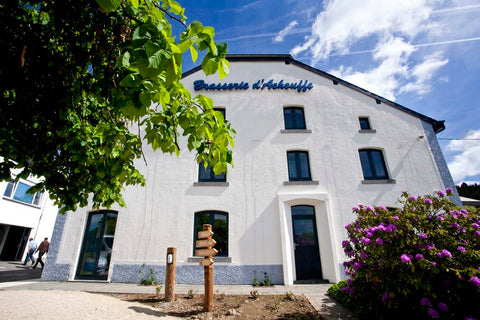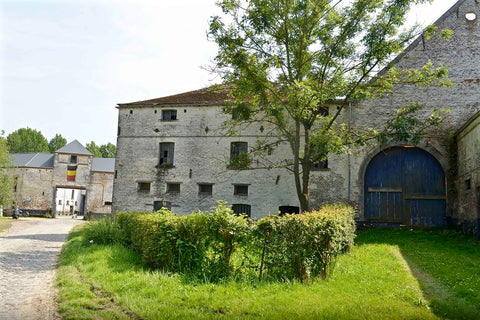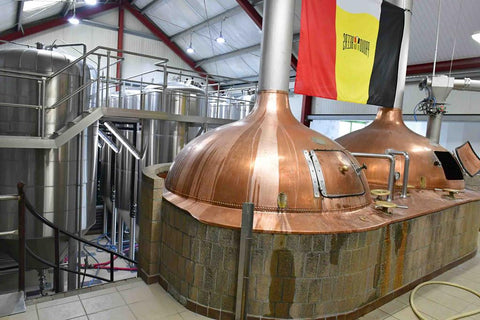- No products in the cart.
Brouwerij der Trappisten van Westmalle

The Beginning – 6th June, 1794. Ten French monks take up residence in the wooded moors of the Kempen, on the ancient road between Antwerp and Turnhout. These Trappist monks plan to construct an abbey, based on the plan of Notre Dame de la Grande Trappe, in Soligny-la-Trappe. They seem a blessing for this poor, war-ravaged region. But a short-lived one, at least at first. The French Revolution soon spills over into this part of the world, making them flee into exile in Germany.
That wasn't to be the end of the Trappists of Westmalle, however. They were able to return in 1802. And while the abbey's buildings sustained much damage under Napoleon, Westmalle begins to flourish – by 1842 the abbey has received official recognition.
But maybe its true calling could be said to have begun in 1830. That's when Father Bonaventura Hermans was appointed Head Brewer. In a former life he was a pharmacist and healer, skilled in the use of herbs. This was by no means a coincidence – in those days beer was considered a beverage beneficial to health.
It was in 1848 that Westmalle strode firmly onto its path to beer greatness, when a genuine brewer joined the ranks: Ignatius van Ham. The fathers now started to sell their beer, following the example set by fellow Trappists of Chimay. The brewing of refectory beer for the monks’ own use commenced in 1856. In those days, the beer came from wooden barrels stored in the cellars, and was poured into jugs to be served in the refectory. But the wily monks of Westmalle were already selling their stalwart brews at the gates of the abbey.
The 20th-century began well for the increasingly sought-after beers of Westmalle. The first use of bottles dates from around 1900. But, as with most breweries in Belgium, the world wars were not kind to the abbey.
The brewing hall was dismantled completely during the First World War and the brewery resumed production only in 1922. At this time there were two types of beer being produced: ‘extra gersten’ (extra barley) and ‘dubbel bruin’ (double brown). In 1933 the ‘Trappistenbier’ name was trademarked, and Westmalle expanded its production, with a view to supporting the local labour market. The recipe was adjusted in 1926, and this beer, which has now become somewhat heavier, is what served as the basis for the current Dubbel.
But it was a third beer which was to cause the name of Westmalle to be forever engraved in the brewer's roll of honour. The Westmalle Tripel is generally recognised as the ‘mother of all tripels’. This type of beer was brewed for the first time here in Westmalle, when the new brewing hall was inaugurated in 1934.
Around the same time, the blond table beer Extra (only available in the abbey) was added to the range. Led by the Trippel, Westmalle's beers became increasingly popular, post-war. That success brought with it new dilemmas for monks dedicated to the Trappist way. Like the other Trappist breweries, Westmalle decided it would remain responsible for product quality, brand development and marketing. A conscious decision was made to keep brand advertising low-key, in line with the product ethos and the traditions of the abbey.

That remains today, with the monks still taking strenuous efforts to avoid their religious heritage being turned into a purely commercial product. To that end they are willing to make financial sacrifices. There are only two hundred and fifty cafés in Flanders that are allowed to serve Westmalle on tap. Being selected as one of the few is a privilege.
These ‘ambassadors’ of Westmalle are chosen carefully, on the basis of the image they project, the type of beer they sell, the owner’s reputation etc. Westmalle is even takes responsibility for the cleaning of the tap installations, including the covering the cost.
Having said all this, it should not be forgotten that Westmalle is something more than just an iconic brewery, and a Trappist beer. The abbey also runs a state-of-the-art agricultural business covering 300 hectares. There are 120 dairy cows, soon to be increased to 200, living in brand new quarters.
There is also a gleaming new cheese dairy, taking Westmalle's much-loved artisan cheeses – made here since 1860 – into the new millenium. No doubt that pioneering ten-some of 18th-century French monks would be proud of the edifice built upon their founding efforts.
The Brewing

Inside and out, Westmalle is an undisturbed oasis of peace and quiet. Not withstanding that, within these abbey walls, around 120,000 hectolitres of Trappist beer are produced every year. So what is the brewing process like for a place where matters spiritual and practical run in parallel? Well, let's just get started with the technical nitty-gritty.
Like their Rochefort confrères, Westmalle uses spring water for its beers that is rich in calcium. It is pumped up from a depth of 60 metres, before being filtered to remove the iron deposits. However, the water’s other mineral content is preserved, so as to feed the yeast. The list of ingredients added includes: barley malt (summer malt), pale malts, 'caramout' (caramel malts) and candy sugars (for the Dubbel). Not forgetting the hops. All these ingredients are subject to the most stringent of selection criteria.
First of all, the malt and water are mixed together (what they call the ‘beslag’ here) and heated to a temperature of 73°C – this is how the sugar is extracted from the the malt. The mixture is then filtered at 78°C. The liquid wort is then added to the boiling kettle. It will be simmered there until it reaches the required density.
The brewer will then add the hop flowers in three stages, with the dosage specified for every stage. The hop flowers will have been weighed by hand beforehand. The cooking process aims to dissolve the active ingredients of the hop (etheric oils, polyphenols, and all the rest), so that the hop aromas are liberated, free to contribute to the complex character of the Westmalle beers.
The hops are removed after the boiling stage, and the wort is cooled down to a temperature of around 20°C. The main fermentation stage – during which the Westmalle proprietary yeast will set to its work – will take one week. After that, the beer will rest in ‘lagering’ tanks, at a temperature of 10°C.
The Dubbel will rest longer – for two weeks – while the Tripel requires around three. Once the beer is well-rested , the brewer will remove the remaining proteins and yeast using a centrifuge. The brew is now poured into a storage tank, to which candy sugar and active yeast will be added.
This active yeast is to ensure, of course, that these Trappist beers re-ferment, either in the bottle or in barrel. Re-fermentation in the bottle does demand time and space, but it makes an important contribution to the unique Westmalle character.
The quality of these beers would not be the same without the renewed interaction between beer and yeast. And plenty more time. After bottling (or barreling), the Dubbel will need to mature for two weeks in the abbey cellars, where it will be kept at a temperature of 21 to 23°C. The Tripel will need a maturation period of three weeks.
The brewer states that the Westmalle beers are best drunk between two and six months of age, perhaps one year at the most. If you keep them for a longer than that, then you will find traces of madeirisation and oxidation, which degrades the enjoyment for many.
The brewer’s current aim is to improve the taste of the beer if it is stored for longer, ensuring it retain its fresh and fruity character. Respect for the product, and for the consumer, remains paramount for the monks of Westmalle.
The Brewers

The rule of St. Benedict allowed for the monks to enjoy a beverage from the local region: hence the reason that French Trappists took to the brewing of Flanders ales. However, it's sad to note that there are no longer any monks working directly in the brewery. When the late Brother Thomas (brewer), Brother Amandus (Sales Director) and Brother Lode (General Manager) stepped down, in 1990 due to their age, they were not replaced by other monks.
The brewery is still tightly bound to abbey, however. The Board of Directors is made of three monks, plus three lay members. Professional brewer, Jan Adriaensen, is now the Head Brewer.
He started his career at Westmalle in 1982. Jan now watches over the quality of Westmalle’s own beers, and also carries out analyses for his colleagues at Westvleteren and Achel.
But the Trappists of Westmalle remain the ultimate guardians of their beer. The Abbot Father feels that it is up to the monks to safeguard the monastic character of the brewery, and its very particular economic approach. It's the only way to ensure that the Authentic Trappist Product label is not an empty slogan. So, despite its global profile, and the high demand for its beers, the foremost concern of the Westmalle brewery is to satisfy the needs of the local market. Reckless growth often means less attention to detail – that's how Westmalle sees things.
By keeping their brewing artisanal in philosophy, flexibility is preserved. For example, the brewer will dose the hops by hand, if required. Or if the hop bells have been part-damaged by frost, he will not use them.
But respecting tradition does not mean that you are standing still; rather, such respect is founded on progress. Westmalle is a decidedly modern brewery: after all, working in a needlessly quaint and old-fashioned way could put quality at risk. As a result, regular investments have been made to improve the quality of the infrastructure, ever since 1950.
The crown of all of its investments was the computerised brewing hall, which was inaugurated in 1992 and is still in use. Change is still ongoing, however. The year 2015 will see the opening of a new brewing hall, which will increase current capacity by 25 per cent.
Furthermore the brewery is planning to build new yeast cultivation areas, and to expand the subterranean warm rooms from 3,000 m2 to 4,800 m2. The tricky balance of tradition and progress is a never-ceasing one, it seems, for Trappists of Westmalle.
The Beers
The Visit

There's good and bad when it comes visiting Westmalle. The bad news is that neither the abbey or the brewery are open to visitors. The good news is that the Café De Trappisten, just opposite the abbey, offers plenty of opportunity for eating and drinking the fruits of Westmalle. Here, you can watch a film about life and work at Westmalle, while indulging in the some of the best in Trappist beer, cheese and cuisine.
And while less spiritually uplifting than those of the abbey, the cafés around the abbey have a their own tale or two to tell of the history of Malle (West- and Oost-). It all started in 1885, when, opposite the avenue leading to the abbey, a stop was built for the steam tram. This was baptised the Statie Trappisten.
This fascinating wonder of steam technology was only replaced by a bus in 1960. The tram company building has now been converted into a café. But this isn't, in fact, the Café De Trappisten. That's a separate building with a history that goes back a little further. In 1841 Joseph Van Uytsel, nicknamed ‘Jef den boer’, started up the first café in this spot. When he died, in 1848, the inn changed its name into ‘Huis Ten Halve’, or the Halfway House.
From 1923 onwards this establishment has been known as Café De Trappisten, becoming a venerated institution in the Antwerpse Kempen region – and a classic day trip for the ‘Antwerpenaars’.
But in 2008, with increasing visitor numbers, the ‘white villa’ was almost completely rebuilt, to make way for an upgraded new hostelry.
Nowadays, only the entrance reminds you of the old building. The reason for its popularity becomes apparent, once you appreciate its 'special treat': you can enjoy Westmalle Dubbel on tap here.
The house specials also include a ‘half-om-half': a glass containing half a bottle of Tripel topped up with freshly poured Dubbel.
There are some other classics on the menu: a Trappist cheese sandwich, cheese croquettes, a stew with Westmalle Dubbel, quiche, croque and even ice cream made with Westmalle beer.
The Location

Sandy heathland, forests and picturesque villages make up Westmalle's surroundings, here in the heart of the Antwerpse Kempen region. Many of the dwellers of the 'City of Diamonds' (Antwerp) gravitate here, attracted by its peaceful atmosphere and secluded green havens. Westmalle in fact has a counterpart to the east – Oostmalle.
Not far from there you'll find the extensive parklands surrounding the Castle of Renesse. And in the centre of Oostmalle itself you can't really miss its famed ‘amputated’ church tower. This is a relatively modern disfigurement – a tornado destroyed part of the church in 1967.
The nature reserve of Zoerselbos (400 hectares) is found near the village of Zoersel. And right on the edge of this forest is ‘het Boshuisje’. This cottage inspired Flemish writer, Hendrik Conscience, to create his novel ‘De Loteling’ (‘the Conscript’) about a farmer’s son who was conscripted into Napoleon’s army. Nowadays the building is a popular tavern with a spacious garden terrace.
The visitors’ centre opposite it provides information on the flora and fauna of the region – which includes a remarkable tree. The villagers of Zoersel were baptised, married and buried underneath this old lime (or linden) tree, down the ages. This ancient tree, which also witnessed many village feasts, was sadly felled in 1974.
But two artists have since transformed its trunk and branches into a record of local village history. Pol Van Esbroek sculpted eighty-five figures from the soft lime wood. The branches bring the story of 'De Loteling' back to life.
According to the tourist guide, this is also the ‘Land van Playsantiën’, or the ‘land of pleasures’ – a nod and a wink towards the many residences and castles once owned by the gentry, in this part of the world.
Nobility or not, the pilgrimage destination of Drieboomkensberg is the ideal spot to take a break for today's visitors. A little further on, and some splendid views across the striking landscape of the Brechtse Heide await you.
Getting There & Around

Westmalle lies 38 kilometres from from Antwerp. By car, take the E34 motorway towards Eindhoven, looking out for the Zoersel exit – turn right towards Zoersel. Drive through the village centre and then take a left towards Westmalle. Coming from the Hasselt-Luik (Liège) direction, head along the E313 towards Antwerp, and exit at Massenhoven. Look out for the right towards Zoersel, then drive straight through the centre, keeping on towards Oostmalle – or you can turn left for Westmalle.
The Antwerp-Turnhout bus stops at Westmalle. The bus line 410 has six different routes, two of which run fast buses that stop at Malle. Café De Trappisten makes an excellent starting point to explore the rural and well-forested Kempen area. In fact it is the starting and finishing point for the Trappistenpad route (8 km).
Once you have passed the abbey, you'll quickly notice the silence. Through forests and long avenues, bordered by oak and chestnut trees, you will eventually reach the pilgrimage venue of Drieboom- kensberg.
A further two recommended walks: the Drieboomkenspad (12 km) that leaves from the Sint-Martinuskerk at Westmalle, and offers enjoyable vistas over the Brechtse Heide area. The ‘Molenpad’, or mill trail (7.5 km) also takes you close to the abbey. Leave from the Scherpenbergmolen mill.
The town of Malle, created by the fusion of a number of villages, offers five further signposted walking routes, which together will show you most of what the area has to offer. Or you could get on your bike and explore the Trappistenroute’ tourist trail (25 km or 32 km) that departs from the abbey. Finally, there are horse-and-wagon tours that take you past the beauty spots of the Kempen region.
Gastronomy, Food & More Beer

Westmalle abbey has been home to a cheese dairy since 1860. Here the brothers continue to craft an unpasteurised, semi-hard cheese using the full-fat milk from their own dairy herd. The cheese is slightly salted and has a smooth, homogenous structure.
Enjoy wedges of it in a ‘Trappist cheese sandwich’, hot and melted in cheese croquettes, or as part of other delicious dishes on offer in Café De Trappisten. And if you want to treat yourself to a fresh chunk of Westmalle cheese, then just press the bell at the gate, the main entrance to the abbey.
Another regional specialty is the 'Kempense boerenhespen', the farmers’ hams. The farmers on the heathlands fatten up their pigs all-year round, to sell the meat to butchers in Antwerp.
The hams were once salted and dried in the kitchens or living areas of the farms around here. These regional farmers’ hams are famed or their length, and are made from the larger pigs. Not many products are as tightly tied to local terroir as the ‘zwarte pensen’ or blood sausages (black pudding). Every village has its own special way of preparing this delicacy.
These Kempense ‘bloedworsten’ all have a characteristic taste: mildly seasoned with pepper and salt, with just a pinch of chilli and nutmeg (without the addition of onions). These ‘pensen’ have quite a firm structure, but are light at the same time.
Another beloved Kempen dish is bacon, where 'lean' is an unknown word – here bacon comes richly streaked with fat. The pork bellies, professionally boned and sliced, are massaged with a mixture of coarse sea salt and finely ground salt, and then dried for a week. The salt is rinsed off, and the bacon will be hung to dry once again.
This is how the butcher produces solid pieces of bacon with a beautifully white layer of fat, contrasting sharply with the dark red meat. ‘Spek’, or bacon, used to be part of the staple diet throughout Belgium. Its nostalgic taste certainly deserves a place in any authentic Kempen kitchen – or on the plate of any Kempen visitor.
More Info
Tourist information for Malle:
Toerisme Malle
Antwerpsesteenweg 246
B-2390 Malle
Tel: +32 (0) 3 / 310 05 14
Website: www.toerisme-malle.be
Email: toerisme@malle.be
Tourist information for Antwerp Province:
Toerisme Provincie Antwerpen
Koningin Elisabethlei 16
B-2018 Antwerpen
Tel.: +32(0)3/240 63 83
Website: www.toerismeprovincieantwerpen.be
Email: secretariaat@tpa.provant.be
Contact

Brouwerij der Trappisten van Westmalle
Abdij Westmalle
Antwerpsesteenweg 496
B-2390 Malle
Antwerpsesteenweg 496
B-2390 Malle







